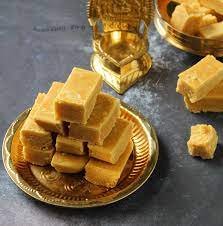Mysore Pak, a dessert that embodies the regal flavors of Karnataka, has become one of India’s most cherished sweets. Its rich texture, decadent flavor, and melt-in-the-mouth quality have earned it a special place in the hearts of millions. While it’s a common delight today, its origins trace back to the royal kitchens of Mysore, where it began as an exclusive delicacy created for royalty. What started as a royal experiment soon became a beloved treat enjoyed by people across the country, and its evolution over time is a story of both culinary innovation and cultural significance.
The roots of Mysore Pak date back to the early 20th century, during the reign of Maharaja Krishna Raja Wadiyar IV. The man credited with its creation is Kakasura Madappa, a royal cook in the Mysore Palace. Alok Singh, a food historian at Diga Organics, explains that Madappa’s innovative recipe was born out of a moment of experimentation. “Mysore Pak was first created in the early 20th century by Kakasura Madappa, a royal cook in the Mysore Palace kitchen, during the reign of Maharaja Krishna Raja Wadiyar IV,” he shares. Madappa combined gram flour, ghee, and sugar, which resulted in a rich, aromatic, and indulgent treat. The Maharaja, delighted by the creation, asked Madappa what it should be called, to which the cook responded with “Mysore Pak.” In Kannada, ‘pak’ refers to a sugar syrup-based preparation, so the name was a fitting tribute to the dessert’s roots in the local culinary tradition.
Mysore Pak quickly became a staple in the royal kitchens, a sweet that was not just served to the Maharaja but also offered to special guests and dignitaries. Its texture, both smooth and slightly granular, along with the lavish use of ghee, made it an indulgent treat that perfectly matched the opulence of the Mysore Palace. The dessert’s rich flavors were unlike any other, and it soon gained a reputation as one of the finest sweets in the region.
As the years passed, Mysore Pak began to transcend its royal origins. It made its way from the palaces into local households, particularly in Karnataka, where it became a part of the festive and celebratory food traditions. Its popularity spread across India as families began to prepare it for special occasions like weddings, religious festivals, and birthdays. While the recipe remained largely the same, with its basic ingredients of gram flour, ghee, and sugar, variations began to emerge, as people experimented with different proportions and cooking methods to suit regional tastes.
One of the significant factors that contributed to Mysore Pak’s widespread appeal was its simplicity and the availability of its core ingredients. Gram flour (besan), ghee, and sugar are staples in Indian kitchens, making the dessert accessible to everyone, not just the wealthy. Over time, families started adding their personal touch to the dish, adjusting the texture and sweetness to their liking. Some even introduced cardamom or saffron to enhance the flavor, adding a subtle aromatic note to the already rich taste.
Another reason for Mysore Pak’s lasting popularity is its versatility. It can be made in a variety of forms, from soft and melt-in-the-mouth versions to firmer, more textured ones. In recent years, a healthier version of Mysore Pak, using less ghee and sugar, has gained popularity among health-conscious individuals, reflecting the changing dietary habits of today’s consumers. However, the essence of the dessert has remained unchanged, and it continues to evoke the same sense of indulgence and celebration it did when it was first created.
Mysore Pak’s story also highlights the cultural importance of food in India. What began as a royal delicacy has now become a symbol of hospitality and joy across the nation. It represents not just the culinary richness of Karnataka, but also the way food brings people together, whether it’s at a grand celebration or a simple family gathering. As the years pass, Mysore Pak continues to evolve, but its place in Indian culinary culture remains steadfast.
Today, Mysore Pak is not just a dessert; it is a symbol of tradition, creativity, and community. It serves as a reminder of how a simple experiment in a royal kitchen can result in a dish that transcends time and place, delighting generations with its rich taste and cultural significance. From the kitchens of the Maharaja to the dining tables of millions, Mysore Pak has truly won the hearts of India.
As the popularity of Mysore Pak grew, its influence spread beyond Karnataka, leaving an indelible mark on the culinary landscape of India. What began as a regional delicacy soon gained national recognition, thanks to its inclusion in the traditional sweet offerings during major festivals such as Diwali, Ganesh Chaturthi, and Pongal. The dessert became synonymous with celebration and indulgence, served as a token of goodwill during social gatherings and ceremonies across the country. In many ways, it became a symbol of the sharing of joy and prosperity, a gift exchanged between families and friends during special occasions.
With the global spread of Indian cuisine in the last few decades, Mysore Pak has also found its way into international markets, where it is loved by the Indian diaspora and food enthusiasts alike. Indian restaurants across the world now feature it as part of their dessert menu, bringing a taste of India to people far from its birthplace. The inclusion of Mysore Pak in the international culinary scene has further elevated its status as a beloved Indian sweet. As global demand for authentic regional delicacies increases, Mysore Pak’s rich history and connection to the royal kitchens of Mysore continue to spark interest among food historians and culinary explorers.
In addition to its cultural significance, the continued innovation of Mysore Pak reflects the broader evolution of Indian sweets, where tradition meets modernity. While some purists stick to the classic recipe handed down through generations, others are experimenting with contemporary twists, including incorporating local flavors and healthier ingredients. Today, you can find Mysore Pak in various shapes, sizes, and even fusion versions that blend the traditional with the contemporary, offering new flavors without compromising on the essence of the original recipe. This adaptability has helped Mysore Pak remain relevant and loved by new generations, ensuring that its legacy continues.
As more people learn about the intricate art of making Mysore Pak, its popularity shows no signs of waning. The dessert’s timeless appeal lies in its simplicity, its rich taste, and its ability to evoke a sense of nostalgia and comfort. Whether made in the lavish kitchens of royalty or in a home kitchen with love, Mysore Pak represents the very spirit of Indian hospitality. It stands as a testament to how food can connect people across time, cultures, and borders. From a royal kitchen experiment to a beloved household favorite, Mysore Pak’s journey is one of culinary excellence and cultural pride, ensuring it will continue to hold a special place in the hearts of Indians for generations to come.



